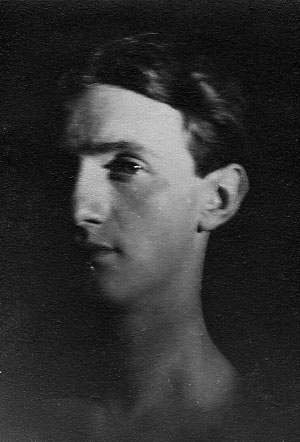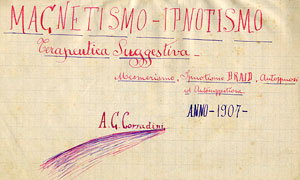EDUCATION
Arnaldo Ginanni Corradini, was born in 1890, the first of four children. His brother Bruno, secondborn, was two years younger. Their father, Count Tullio, was a well-known criminal lawyer, Member of Parliament, Mazziniano and mayor. To pay homage to Arnaldo da Brescia and Giordano Bruno, he named his sons after them (while Ginna and Corra were respectively the two stage names under which they began to sign their work after 1914). During their studies and as young adults, their lives go hand in hand and their stories are inseparable from one another.

Consequently, the two Ginanni Corradini brothers were both noble and wealthy, and also well-connected in Ravenna’s cultural society. Arnaldo attended the Academy of Fine Arts, while, Bruno was more inclined towards literary studies. The intellectual symbiosis created between the two brothers during their formative years profoundly marked all their artistic production during their youth. Together, they studied foreign languages and immersed themselves in reading the classics of literature and philosophy, listening to the great masters of music, and learning about art history. Together they embarked on metaphorical journeys into all the new things that came from the universe outside Ravenna: theosophy, anthroposophy, psychoanalysis, hypnotism, metapsychics, oriental philosophies and disciplines, occultism, alchemy and also scientific discoveries not only in the field of medicine, but also in alternative medicine and physiognomy. The province of Emilia and Romagna, although small and provincial at times, offered the two young men interesting stimuli nevertheless, especially in spiritual awareness and the study of the occult, and in particular in theosophy. In fact, the brothers attended conferences hosted by the Theosophical Society in Bologna where they met intellectuals who were experts in the matter. They also read books and treatises avidly published by Dourville and Chacormac:
“We read the occultist Elifas Levi, Papus, theosophists such as Blavaskj, Steiner, Besant, secretary of the Theosophical Society, Leadbeater, Edouard Schurè.”
Subsequently, Ginna and Corra’s attention focused on the thought of Rudolf Steiner, especially at the time when the Austrian philosopher founded the Anthroposophical Society and delved more deeply into themes of art and religion.
The Ginanni Corradini brothers, made other important encounters with Luigi Savini, a declamatory actor, and with Francesco Balilla Pratella, the well-established musician from Lugo di Romagna who was to be the link with Filippo Tommaso Marinetti and the Futurist Movement.
Trips to London and Paris in their youth allowed Arnaldo and Bruno to expand their knowledge of ancient art as well as contemporary European artistic trends. The evolution of their thought began with the comparison between different artistic trends and disciplines combined with the transposition of Steinerian themes, in the search for a unity between the arts that would allow, thanks to the development of occult spirits, to achieve the portrayal and thus the knowledge of the ‘supersensitive’ world of nature.
Page from Arnaldo Ginna’s notebook of 1907.

Text by Lucia Collarile
